The Opportunities and Challenges of the Changing Public Services Landscape for the Third Sector in Scotland: A Longitudinal Study Year Three Report (2009-2012)
The report provides findings from the the first three years of a qualitative longitudinal study on the third sector in Scotland
APPENDIX A: CASE STUDIES
This section provides case study analysis for 5 of the 8 case study organisations that participated in the research and gave permission for their information to be provided. These case studies demonstrate the range of strategies and responses that organisations have taken over the period of the research. They are presented to show change over time by demonstrating the prevailing issues and selected responses year by year.
NATIONAL HEALTH AND SOCIAL CARE PROVIDER (anonymous)
| NATIONAL HEALTH AND SOCIAL CARE PROVIDER | |||
|---|---|---|---|
| Field(s) of Activity | Mental health, homelessness and addictions | ||
| Geographical Coverage | Across Scotland | ||
| 2009/10 | 2010/11 | 2011/12 | |
| Number of Staff | 745.73 (FTE) | 674.39 (FTE) | 652.27 (FTE) |
| Annual Income | £22,424,000 | £23,336,000 | N/A |
| Proportion of Income from Public Funding | 85% from LAs and SG | £86% from LAs and SG | N/A |
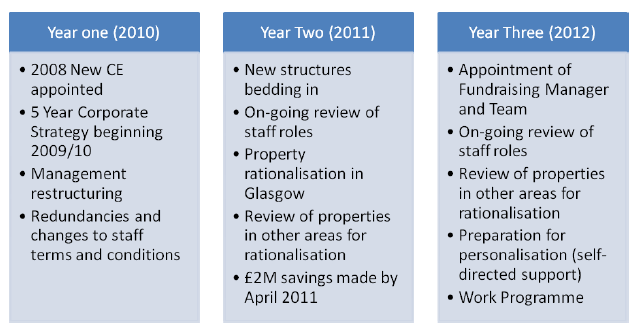
Background
A third sector organisation helping those with mental health problems; homelessness issues; addiction issues and those who experience social exclusion. The organisation was initially set up to support the interests of those with learning difficulties and mental health problems. They provide services such as accommodation and rehabilitation; and are committed to the principles of user involvement and in doing so challenging discrimination. The organisation also has a lobbying role and tries to influence government policy in Scotland.
Year One (2010)
In 2008 a new Chief Executive (CE) was appointed. With the support of the Board, the CE aimed to develop a strategic focus. Prior to this time, there had been some 'mission creep' whereby the organisation had become dependent on public funding. They now wanted to re-establish their identity as an independent charity. To this end they created a Corporate Strategy which provided a new strategic direction for the organisation and set specific targets to be achieved over five years - starting in 2009/2010. The strategy included 5 key themes with 16 outcomes related to these aiming to give the organisation consistency of direction over the longer term. To reflect shorter term external changes, key performance indicators were reviewed annually. The overall aim was to expand service provision beyond traditional local authority-funded models to encompass charitably-funded services as well as to increase campaigning and awareness-raising activity. As part of strategy the organisation needed to identify cost savings in order to be able to invest in the areas identified in the strategy.
"Ultimately our aim is to support more people [with mental health problems] in high quality services…the challenge to that is to compete at the moment and particularly over the last year we've had to…radically look at our cost structure and financial model in order to be able to still compete in what is a very competitive market in terms of a cost perspective".
(Senior Manager, year one)
The organisation needed to make changes in two key areas: management restructuring, and changing staff terms and conditions.
The purpose of the restructuring was to create a leaner, flatter management structure which could respond quickly and flexibly as required. This was a difficult decision because it meant making a number of staff redundant in the short term, but in the longer term it would ensure a more focused and effective organisation.
The strategy also involved increasing workforce flexibility, for instance, staff in different locations being able to cover for each other. To this end, the organisation (in consultation with the union) changed the terms and conditions of staff. This included increasing weekly hours from 35 hours to 37.5 hours and rolling most statutory holidays into an increased annual leave entitlement.
Year Two (2011)
By year two, the new management structure and staff terms and conditions were bedding in. These had entailed cultural change within the organisation and effective communication and information had been important in that process. For instance, part of their enabling strategy was to communicate differently with staff during the initial period of change. This included speaking to over 300 staff face-to-face in regions all over Scotland over a period of three months. It also included periodic bulletins distributed to all staff outlining what was happening and how staff could engage with the process.
The organisation were also looking at other proposals in the strategy, such as property rationalisation (closing satellite offices and centralising staff into a fewer number of central offices). By year two, the organisation had just completed the rationalisation of several existing Glasgow offices into one head office, thereby saving on rental costs.
The review of staff roles remained on-going, and where a member of staff left a post voluntarily, the role was reviewed before recruiting a replacement.
By April 2011, the organisation had saved £2 million. This enabled them to help fend off some of the immediate funding pressures as well as giving them investment funds that they could decide how to allocate in line with their strategic aims.
Year Three (2012)
In year three, the organisation continued to look at further property rationalisations. In the previous year, they had rationalised the offices based in the Scottish Borders as well as maximised use of existing spaces:
"…in the Borders we've relocated…3 services, so rather than being all spread out, they are now all in the same office and that's the approach we've been taking really is continuing to see not rationalising for the sake of it but where we have several properties can we bring them together. We can't always, but to see where we can".
(Senior Manager, year three)
As in year two, review of staff roles remained on-going. By 2011/12, overall staff numbers (full-time equivalents) had been reduced to 652 (down from 746 in 2009/10).
In accordance with the Strategy, the organisation had appointed a Fundraising Manager who started in Spring 2011. Following this, a small fundraising team was appointed. This team aimed to raise income generated through fundraising, although at the time of the year three fieldwork (carried out between February and April 2012), it was too early to ascertain the level of success.
By year three, the organisation was preparing for the move towards personalisation of services in the Glasgow area. In addition, they were also sub-contracted through the Work Programme although had received limited clients. Both of these programmes represented a challenge and an opportunity for the organisation in terms of changing the way that they worked, and potential for new work. As well as the changes made in years' one and two, they had also been making greater use of part-time staff in order to be more flexible in meeting client demands. However, there were still uncertainties about how they would need to change further in the future in order to respond to these new programmes.
LEAD SCOTLAND
| Lead Scotland | REGIONAL LEARNING PROVIDER | ||
|---|---|---|---|
| Field of Voluntary Activity | Disability Support | ||
| Geographical Coverage | 8 local authorities in Scotland | ||
| 2008/09 | 2009/10 | 2010/11 | |
| Number of Staff | 16 all staff including PT | 17 all staff including PT | 22 all staff including PT |
| Annual Income | £562,793 | £491,941 | £524,840 |
| Proportion of Income from Public Funding | 93% public funding | 75% from LAs and SG | 61% from LAs and SG |
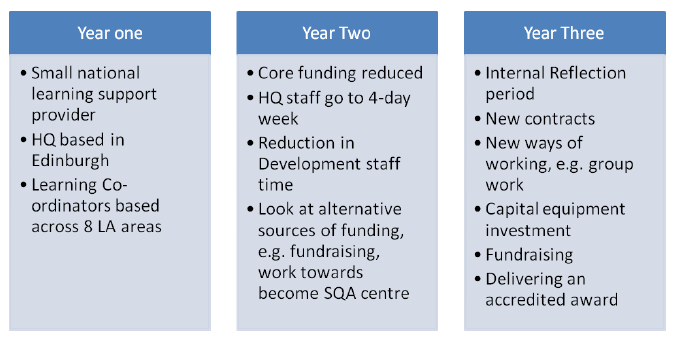
Background
'Linking Education and Disability' (Lead) is a specialist Scottish-based third sector organisation that seeks to widen access to learning for disabled people and carers of disabled people. The organisation is limited by guarantee and is registered as a charity in Scotland.
Year One
Learning Co-ordinators based in eight local authority areas across Scotland provide guidance and support to disabled people, carers of disabled people and other socially and/or educationally excluded or isolated people. Learning Co-ordinators also support volunteers to provide additional support to the client group. Each learner is supported to develop their own action plan, which results in a tailored and unique service from Lead. Head Office is based in Edinburgh. Lead Scotland also provide capacity building and training to external agencies, including consultancy services to support other organisations who want to widen access to learning or offer more inclusive volunteering opportunities.
Funding came through a mixture of a Scottish Government core grant and project funding which came via a variety of sources, but particularly local authorities.
The organisation was also looking at the potential to develop social enterprise activity in the future in order to build the longer term sustainability of the organisation. There were some concerns raised about ability to cover core costs as well as unfair competition from public sector providers.
Year Two
By year two, the organisation had experienced a 20% cut to their core grant from the Scottish Government. They carried out a staff consultation in order to review what could be done to save this cost. Lead was keen to avoid redundancies so decided to reduce the hours of staff at head office from 5 days to 4 days a week. Development Officer (who provide capacity building and training to external agencies) time was also cut from 10 days to 2 days per week, with one officer taking voluntary redundancy. This meant some re-organisation of tasks, with some support and administration functions being transferred to the Learning Co-ordinators.
At this time, the organisation was also developing fundraising activities through encouraging volunteers and learners to raise funding through 'Friends of Lead'. They were also aiming to increase income from legacies and had produced a leaflet to this effect. In addition, they hoped to develop activities working towards providing SQA awards, although this was a longer term strategy.
Year Three
In year three, Lead had won a number of new contracts. This included a pilot project through the Big Lottery Fund (Get Connected and Lead project) and hosting a new post of Policy and Information Officer. They were also spending more time identifying alternative sources of funding.
The CE had carried out an internal review of the organisation during this time in order to divine a future strategy and how to reduce costs. Out of this had come a number of initiatives including looking at new ways of working. For instance, they had previously supported high needs clients with one-to-one support. While this remained important, they had recently started to do more group work which represented a progression route for clients and freed up some staff time to meet increasing demand.
"I had a 3 month sabbatical and it was really about 'Is there still a place for Lead in 21st century Scotland or is the way we deliver our service too expensive in the current climate?' The results of that 3 months…was that there is definitely still a need…one of our USPs is our one-to-one support in home or in a community setting that the individual is comfortable with but that's the really costly side of what we do… we are not going to do away with that if at all possible, but they progress then onto a group learning situation… We probably do a lot more group type of activity than we used to".
(Senior Manager, year three)
Lead was also using technology in order to reduce staff costs. As a small national organisation with staff geographically dispersed they received some funding to invest in capital equipment such as video conferencing and Adobe Connect with allowed staff to communicate without incurring the travel costs. They had made a difficult decision, however, to reduce the money spent on advertising and marketing because this was deemed less effective.
The organisation continued to develop fundraising activities, although the income generated was still small. They had, however, made significant progress towards becoming an SQA recognised award centre. Although this goal was still way off, by year three they were able to deliver accredited awards including SCQF Level 3 and Level 5 Community Action and Leadership through the Get Connected and Lead project[38].
FORTH SECTOR
| Forth Sector | LOCAL EMPLOYABILITY PROVIDER | ||
|---|---|---|---|
| Field of Activity | Mental health and employability | ||
| Geographical Coverage | Edinburgh | ||
| 2008/09 | 2009/10 | 2010/11 | |
| Number of Staff | |||
| Annual Income | £1,431,703.00 | £1,689,997.00 | £1,370,511.00 |
| Proportion of Income from Public Funding | Not available | Not available | 33% |
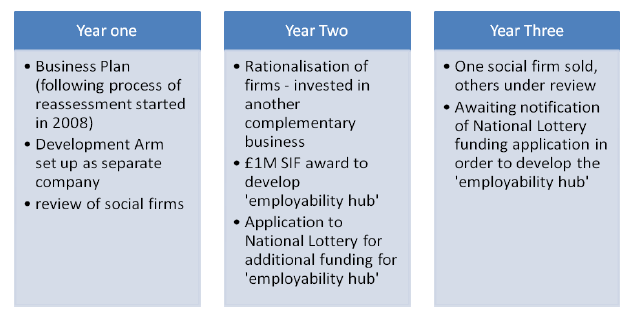
Background
Forth Sector provides 'employability support to aid the recovery of people with mental health problems'. Forth Sector seeks to achieve this aim by offering placements within businesses owned by the organisation and providing pre-employment and in-work support to enable individuals to sustain employment.
Year One
Following a process of reassessment, the organisation developed a Five Year Business Plan:
"One of the key elements from that [the business plan] was about growing ourselves as an organisation - becoming much bigger and much stronger and much more robust and about having social enterprises which would generate income and pay for themselves and not be reliant on subsidy through Service Level Agreements or ESF or whatever else to pay for some of the core staffing costs".
(Senior Manager A, year one)
As part of this, they carried out a review of the existing social firms. At that time, these included a laundry, a soap making business and a guest house which offered supported work placements for clients. In recent years, the businesses had been in a state of flux, with a lack of investment and the economic downturn affecting the viability of some of these.
In the last year, the organisation made the decision to set up Forth Sector Development as a separate company from Forth Sector, the charity. Forth Sector Development provides support for other social enterprises, but still had an important role in the charity, particularly since the social businesses had been struggling.
Year Two
By year two, Forth Sector Development had been doing well, picking up a number of major contracts to support other third sector organisations to develop social enterprise activity.
"[Forth Sector Development] covenants surpluses to Forth Sector, the charity. It is a social enterprise...it is there to generate income and really support the rest of the organisation given that...the businesses at the moment aren't creating a surplus and in fact have been operating at a loss...it has in the past quite heavily subsidised the other parts of the organisation. It's an important source of income...we are trading on our intellectual capital".
(Senior Manager B, year two)
A decision was also made to rationalise the social firms. In order to access some of the organisation's capital assets, they were planning to sell the Guesthouse. They also invested in another laundry business in order to complement their existing business.
At the same time, they had been awarded £1M from the Scottish Investment Fund in order to develop a purpose-built employability hub at a site at Duddingston Yard in Edinburgh's Craigmillar area. With additional funding which they hoped to win from the National Lottery, they hoped to have completed the build and move by summer 2012.
At the same time, they were also looking at what to do with the other social firms that were not proving profitable:
"It's about deciding where you are going to put your energy...and resource...if you're spread too thinly you could be starving those businesses that have the best chance of success of the resource that they need and actually propping something up that is frankly limping along. I think you've just got to make those decisions".
(Senior Manager B, year two)
One senior manager attributed a lack of capital investment in the social firms at an earlier stage as an issue that limited their potential for success. Learning lessons from past experience, the organisation hoped that through significant investment now, they would be able to forward towards a successful and sustainable future.
Year Three
Forth Sector Development continued to do well and had worked with Government, local authorities, private and third sector organisations to provide professional support and consultancy services to develop social enterprise activity.
The Guesthouse had been sold and the profits from the sale had allowed for "a little investment in some of the departments". Meanwhile, the new laundry acquired in year two had been merged with the existing laundry making further cost savings. In addition, they had been successful in pulling down some development funding (from Esme Fairburn) which was:
"Allowing them to review some of the businesses…that's helping some of the development of the businesses, so the businesses are developing and growing…the money's allowed some sales and marketing managers to come on board, one's on board and there's another post coming on board. Their role is to increase the sales for the businesses and that will then generate more income into the organisation".
(Senior Manager, year three)
The Duddingston Yard development project had been put on hold awaiting confirmation of Lottery Funding. There had been some complications with the application resulting in a delay, but it was anticipated that this would be successful and the project would go ahead in the future. It was hoped that this major investment programme would see the number of clients supported increase fourfold, the cost of supporting clients would fall further, the quality of services would improve and trading revenue would double, as well as an increase in the economic and social impact.
ROSEMOUNT LIFELONG LEARNING AND FLEXICENTRE
| Rosemount | LOCAL LEARNING PROVIDER | ||
|---|---|---|---|
| Field of Activity | Learning and childcare provider | ||
| Geographical Coverage | North Glasgow | ||
| 2008/09 | 2009/10 | 2010/11 | |
| Number of Staff | |||
| Annual Income | £1,307,888 | £1,309,493 | £1,494,391 |
| Proportion of Income from Public Funding | Not available | 36% from local authorities | 31% from local authorities |
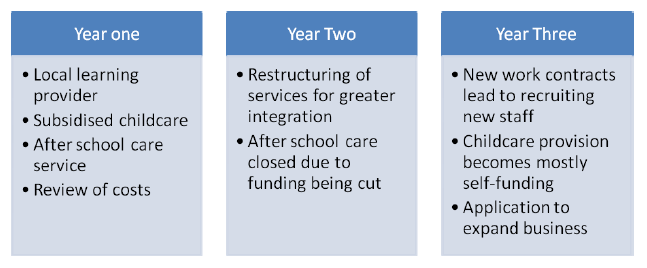
Background
Rosemount Lifelong Learning and Flexicentre are based in two centres in North Glasgow and provide childcare and adult learning opportunities to local communities. It aims to 'reduce poverty by providing high quality childcare and increasing lifelong learning opportunities in an approachable and supportive community setting'.
Year One
Rosemount continued to provide varied and innovative services to local people as it had done in previous years. However, the organisation had experienced greater demands and heavier workloads due to the economic downturn which had seen parents in the local area losing jobs or reducing hours. There was also a downturn in the number of college places that were offered to Rosemount learners.
In response, the organisation carried out a review of costs in order to identify potential savings and planned to carry out a review in the year ahead.
Year Two
In a review of services, the organisation resolved not to "ambulance chase...funding", but to be led by a set of key priorities linked to community need:
"We set our priorities because we are very close to the communities that we serve and we see the need and basically we've been, for a long, long time, about equal balance in our services for children and parents and we respond to the need. Over the years we have stayed fairly true to their key message, maybe over the years we have developed new services that fit with that and the policy changes and every now and again it coincides with us. I would say one area were we are diverging is another one of our principles is that we see education as a route out of poverty and I think that idea has lost popularity with policy makers...but we'll just stick to that because we really firmly believe it's true...and maybe in a few years time the policy will come back round again".
(Senior Manager, year two)
The Board of Directors took the decision to close the after-school care services following several years of sustained losses in providing it. Other local childcare services were able to offer places. Voluntary severance was offered to all staff within Rosemount, rather than compulsory redundancies within the after-school care services. This way staff could be re-deployed across the pre-school nursery services.
In addition, they had also reduced the hours the crèche was provided for in the Flexicentre. They stopped providing the service in the quietest hours between 3-5pm, but still provided a service between 10am and 3pm and in the evening (in busy periods). They found it difficult to raise money to cover the cost of the crèche and parents only paid a nominal amount (the parents had no money themselves as most were signing on). Rosemount had tried to get money for the crèche included in funding applications for adult learning programmes but found that funders tended to be unwilling to pay for this service.
There was also major restructuring within Rosemount Lifelong Learning with two previously separate departments, Family Links and Guidance/Employability, merging under one line management structure. The 'Integration' Agenda was introduced by the new interim CE (following the early retirement at the beginning of 2011 of the previous CE). Programmes previously run within these departments were integrated within the same department resulting in more 'cross fertilisation' and good practice. There was also a perception that this would also be more attractive to funders because they were "getting more bang for [their] bucks".
Year Three
By year three, the organisation had further reduced overheads through moving accommodation. They had looked at staff costs and invited staff to consider alternative working hours where suitable (e.g. term-time and part-time working), also encouraging more flexibility. The childcare provision was moving towards more fee-paying, where parents paid for places. There had also been some management restructuring with managers being given responsibility for their own budgets.
Working in partnership, they had also applied to the Big Lottery Fund to refurbish the Flexicentre and make it a community café and learning space through the 'Our Place' initiative.
The organisation had been successful in winning a substantial new contract working with young parents as well as gaining an extension to an existing one resulting in 6 additional staff members being recruited.
They had also, or were intending to, submit bids for additional funds because despite a pro-active and positive approach, there were still uncertainties about future with two major funding streams coming to an end in the summer.
THE WISE GROUP
| Wise Group | NATIONAL EMPLOYABILITY PROVIDER | |||
|---|---|---|---|---|
| Field of Activity | Employability, regeneration and social economy | |||
| Geographical Coverage | Scotland and North East England | |||
| 2008/09 | 2009/10 | 2010/11 | 2011/12 | |
| Number of Staff | more than 400 staff | PTE 153 FTE 420 | PTE 355 FTE 516 | PTE 168 FTE 477 (unaudited) |
| Annual Income | £16,923,623 (2007/08) | £20,759,048 | £32,181,460 | £26,626,084 (unaudited) |
| Proportion of Income from Public Funding | The majority of the income has come from public sources. | |||
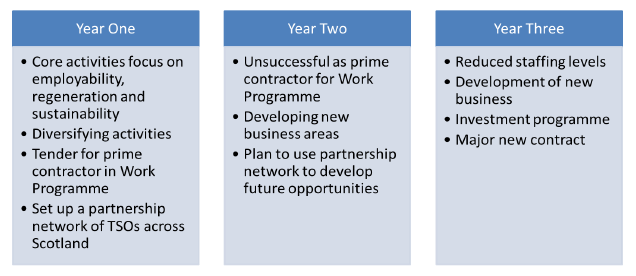
Background
The Wise Group was established in 1983 as a project to address unemployment and fuel poverty in poor areas of Glasgow. The organisations' core activities focus on employability, regeneration and sustainability. Programmes delivered by the organisation help provide people with new skills in the labour market, help for ex-offenders and sustainability advice for corporate and private customers. In 2010, the organisation helped 5,500 into employment and helped reduce the carbon emissions of 150,000 houses.
Year One
Senior managers within the organisation were seeking to diversify their activities whilst ensuring that they remained faithful to the values and mission of the organisation. Partnerships with other third sector and social enterprises were seen as key to the diversification of activities. In order to tender as a prime contractor for the Work Programme in Scotland, the organisation had developed a large partnership network of 153 third sector organisations across Scotland. The network was implemented to provide an assured network of potential partners who could bring a diverse range of skills and competencies to the development and delivery of services.
Year Two
By year two the organisation had learned that it had been unsuccessful in being selected as a prime contractor for the Work Programme. This meant a significant loss of income. The organisation was focused on developing new business areas in regeneration, skills and training, employability, criminal justice, waste reduction, waste minimisation and environmental impacts.
However, the partnership network set up in response to the Work Programme remained an important means to move forward and develop future opportunities. By creating an 'assured partnership network' the organisation could draw upon a wide range of skills and experience and ensure that other Scottish TSOs could share in the benefits of successful bids. The Wise Group undertook an assessment of the capabilities of organisations within the network and had rated them using silver or bronze categories to create a Third Sector supply chain.
"We've got fantastic partnerships which created that improved partnership network of 153 organisations, so we're linked to 153 organisations in ways that we hadn't needed to in the past - now we always said that that wasn't just going to be about the Work Programme but a whole range of opportunities, so we've got a really good base going forward and because we've not committed our finance to that programme, we have the finance to invest in other things and what we would want to ensure is that our managing agency, capacity that we developed in managing supply chains is built upon as well - it might not be on that programme but potentially in other areas where we could bring that to bear - so it's really looking at those key strengths that we have invested in last year in that whole process of professionalisation and understanding and being business-like but being business-like but absolutely driven by our values".
(Senior Manager, year two)
Year Three
Largely as a result of the loss of the Work Programme funding, by year three, the organisation had significantly reduced staffing levels. It had been a challenging time for the organisation going through two stages of redundancies. At the same time this has stimulated thinking about the organisation's purpose:
"The other side of this is that it has made us...rethink what we do as an organisation and what we're about. We haven't changed our basic mission and values about…believing work is the route of the poverty for most people and we are about changing the lives of individuals and communities. So we're still focusing on the same activity but it's made us more creative and enterprising I think... We've got a new business strategy…we're still focusing on the same activity which is employability, sustainability, criminal justice and regeneration and supporting other social enterprises. We have got the balance of what we do away from responding to central government, we still obviously respond to tenders from wherever they come out".
(Senior Manager, year three)
The organisation had also carried out some small restructuring at senior management levels, in terms of revising roles and responsibilities. They were also focusing on new business and investment. They were actively seeking external investment and had already received support through the Scottish Investment Fund to development their infrastructure for bidding for work with the Flexible New Deal and the Work Programme. This included developing IT and management systems. They were concerned to maintain the capacity of the organisation so they could continue to bid for large contracts.
The Wise Group were actively working with the private sector and had developed a partnership with Microsoft and O2 called 'Cloudwise' which was a third sector IT consultancy. They were also in the early stages of business planning for numerous other activities in partnership with others, including: developing ideas for the employability and training element of a national renewable energy scheme; the training element of reuse and recycling of IT equipment; and an empty homes initiative.
The organisation had also been successful in winning a major new DWP project 'FamilyLinks' working with workless families in the North East of England. They were also a sub-contractor to the Work Programme although referrals had been limited at the time of the case study.
Contact
Email: Carol Brown
There is a problem
Thanks for your feedback